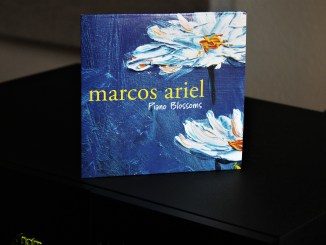I really wanted to review some amplification with 300B tubes. I’ve been listening to some of my writers over the last couple of years, reviewers who have been vocal in their adoration of this DHT, and I felt like I was out of the loop. Thankfully, a 300B amplifier arrived at my doorstep, one that didn’t require me to score some nifty high-sensitivity loudspeakers for review at the same time. That’s because this 300B amp is the Audion Silver Night Limited HP1, and it’s a headphone amp.
Words and Photos by Marc Phillips
It’s not like haven’t heard a 300B tube before. I’ve heard plenty at the high-end audio shows, dealer events and in the homes of audiophiles. But when I dabbled in single-ended triodes and high-efficiency speakers a couple of decades ago, it was all about the 45s and the 2A3s, not the legendary 300B. When Gary Alpern of True Audiophile, the dealer who provided me with the Aretai Contra 100s speakers for review, asked me if I wanted to take the Audion Silver Night home with me, I saw the big 300B on the shipping box and I quickly said yes.
Besides, I had the ZMF Caldera and Atrium Closed headphones in for review, and while I’m pleased with the inboard headphone amp in my new Naim NAIT 50, I wanted something a little more esoteric. In no time at all I had the Audion Silver Night HP1 plugged in, turned on, and matched with those amazing headphones. It didn’t take long to realize I had just entered a new world of sound, one that confirmed the elegance and ease of the 300B valve.
Inside the Audion Silver Night HP1
When I checked out the Audion website for more information on the Audion Silver Night Limited HP1 30th Anniversary headphone amplifier, it took me some time to determine which amp I had in front of me. Audion has many products under the Silver Night moniker–integrated amplifiers and power amplifiers and headphone amplifiers. I’d find a model with the same name that was on the shipping box, and it would be something else with a different face plate with different controls on the website. Part of this confusion is because this Audion Silver Night HP1 is very new, and I had one of the first in the US.
It also turns out that True Audiophile is the exclusive US dealer for this particular model, and that Gary Alpern supplied the information on the Silver Night HP1 that I needed:
“Audion spent the more than 7 years developing an SET Headphone amp that would be worthy of the Audion name. Trust us, we begged them to jump on the bandwagon and slot in a headphone jack. The refused year after year while quietly building and discarding input and output transformers. Until, finally, they created a SET Headphone amp sounds and works like an Audion Stereo SET with major differences over the competition. It’s a remarkable unit.
“Firstly, and most importantly, it uses different taps on the output transformers to select any of the 5 impedances. The majority of all headphone amps accomplish this by way of inexpensive resistor networks. Easy to manufacture, not so great for sonics.
“Of course, Audion winds their own transformers and is very picky on sonics. The output transformer use M6 laminates which are wired with extremely fine wire to get the number of turns needed for each impedance setting. Only the very most expensive headphone amps and ones costing multiples of Audion’s price even consider this process. Also, with this amp you can run 2 sets of headphones at a time (as long as they are the same impedance).
“Have different HP amps for your various headphones due to getting one impedance output? No more with the Audion. This replaces all of them because one simple turn of the Impedance selector makes it a new dedicated headphone amp. Truly amazing for its price.”
The Audion Silver Night HP1, as Gary further explains, is a “new breed” of amplifier for this UK-based company. “Perhaps one of the finest headphone amps on the planet and certainly one of a rare few that is an SET,” he says. You can choose from five output impedances: 8, 32, 150, 300 and 600 ohm. (The 8 ohm tap outputs yield approximately four 4 watts, but it can be boosted to seven at the Audion factory–as long as your headphones aren’t too efficient.)
Graeme Holland, owner of both Audion and Revolver, further clarified the objective of the HP1 like this:
“One of the key aims of the HP1 amp was to allow as many different types of headphones as possible to be used, including reasonably efficient loudspeakers on the 8 ohm tap with a suitable adapter cable. The amp is easily capable of driving pretty much any headphone thrown at it with ease. The other taps 32 ohm 150, 300 and 600 ohm all having ample power to drive headphones.”
Other features include an optional balanced XLR input/output board which can be fitted as well for XLR requirements and for speaker outputs. All XLR and headphone 6.3mm sockets are Neutrik. The Silver Night HP1 is hand-built and hard-wired, with zero feedback.
Audion builds each of their amps, from phono stages to power amps to headphone amps, within the following design parameters:
- Transformers and chokes are design and handmade by Audion: Mains, chokes and output transformers.
- As stated, separate windings on the output transformers for each impedance settings.
- Superior quality parts sourced from Europe or the US. Even the capacitors are made to Audion’s exacting specifications.
- Chassis’ are finished in-house which includes powder coating and electroplating to ensure quality.
- Special voicing of Audion amplifiers requires every part be meticulously designed to meet their standards.
- Every component is hand built usually point to point. Once burned in they listen again in case they are not satisfied before releasing each unit.
Finally, Graeme Holland wanted to mention the flexibility of the Audion Silver Night HP1:
“The power supply was designed to withstand any detailed musical passage and the big transients that are sometimes called for. Having both a 6.3mm jack and a 4 pin XLR socket on the front panel allows that choice of headphones to be quite vast and even bigger if cable upgrades are taken into account. The balanced XLR inputs/outputs on the rear and the 3 unbalanced single ended inputs and unbalanced single ended output (RCA) allows the HP1 amp to be used as a pre-amp as well as the output stage is buffered too.
“The HP1 amp is indeed, an integrated power amp (with the pre-amp built in), with the option of balanced inputs and outputs and the ability to play pretty much any headphone or indeed even loudspeakers.”
Set-Up
I mentioned that the Audion Silver Night HP1 was used primarily with the two ZMF headphones. If you read that review, you’ll know that my new, sprawling headphone rig has been split up into two basic systems. First, I took the easy route and connected my trusty Unison Research Unico CDE directly to the Audion using a plethora of interconnects from Furutech, AudioQuest, Cardas and ArgentPur. I’ll tell you right now–I find it even easier to discern differences between cables when I’m listening to headphones. The perspective, obviously, is far closer and more intimate, sort of a sonic close-up if you will.
The second system included the digital mega-gear I’ve had for the last few months, an Antipodes Oladra music server, the Innuos Pulsar network streamer, and the Merason DAC-1 Mk. II converter. While I enjoyed listening to my favorites in my CD collection, this second round of testing was the one that pulled me in, and caused me to lose track of time.
Finally, I noticed something about the sound of this system that needed to be addressed–lowering the noise floor. It wasn’t the fault of the Audion Silver Night HP1. The real culprit in my headphone rig was simply a lack of any noise reduction and grounding at all. Usually I have products such as my gathering of multiple Furutech NCF devices, the AudioQuest Niagara 3000 power conditioner, and maybe another device I’m reviewing at the time.
In this case, I found a perfect solution to the noise issue–the Computer Audio Design Ground Control GC-1. This is simple, elegant and effective grounding that’s easy to implement without taking too much space on an equipment rack or, in my case, an old oak coffee table. I also placed the Audion Silver Night on a variety of isolation feet–both the Fern & Roby Isolation Feet and the Les Davis Audio Entropic Isolators. Without these devices, the Audion had a slightly dreamy, ethereal quality that was accompanied with just a touch of image instability. With the CAD and the footers, the sound transformed into something more solid and unshakeable.
If you go with the Audion Silver Night HP1 as your headphone amp of choice, I suggest you take precautions to ensure proper grounding and the lowering of the noise floor. I’m not saying the Audion is noisy, but it clearly benefited from the additional TLC.
Audion Silver Night HP1 Sound
While I’m not the biggest expert on the 300B, I do have opinions about this valve’s basic sonic characteristics. When I first heard a 300B amp, I thought it sounded lovely. But I noticed a tendency for the soundstage to take on a fairly spherical form with most of the energy focused on the middle. (In fact, I once tried a CD player with 300Bs and I noticed the same sense of roundness.) That may be why I preferred the more linear sound of 45s and 2A3s, although the latter DHT also truncated the frequency extremes. Initially I thought that 300B sphere of sound would make more sense in my head than out in the room, but that didn’t happen with the HP1 and the ZMF cans.
Graeme Holland had this to say about the 300B:
“The 300B sound is often described as warm and ‘fuzzy.’ I personally don’t like this sound or the analogy given to this tube. The 300B for me is dynamic, detailed, tight and airy with good bass and for want of a better word ‘knows how to party.’ The HP1 was designed to deliver this in spadefulls, tight, controlled and thumping bass along with good highs and coherent midrange. Correct singer placement and the feeling of space and accuracy was the design goal, along with affordability for this type of tube amp.”
To put it succinctly, I was completely immersed in the sound from the very first note and I liked it. I had the sense of walking around the stage while the musicians performed, and that I could let my brain drift from corner to corner, floor to ceiling, and find new discoveries.
In the ZMF review, I noted that I may have preferred the ZMF Atrium Closed headphones with the Audion Silver Night HP1 over the Calderas, even though the open-design cans were preferred with every other amp I tried. The Atrium Closed sounded a little more in control of that dreaminess, and delivered a tactile and thrilling foundation to the deepest bass. I heard more detail on the Calderas, and more texture in the midrange, but the Atrium Closed excelled at preserving the side-effects of the bass–more slap, more strike, more flesh in the percussion.
Listening Sessions
First, let’s talk about Kane Mathis’ stunning Geminus album. I’ve had this CD for a couple of years, and it’s a regular part of my rotation because of its complicated textures, unique instrumentation and sophisticated time signatures. Lately I’ve been drawn back into this music because I feel like people need to know it exists. (I recently had it played at a dealer event, and everyone in the room was enthralled and many took notes.)
What the Audion Silver Night HP1 revealed about this fascinating recording is all the subtle changes in timbre, especially with the percussion. (I’ve mentioned this before, but as someone who is learning the cajon I naturally pick it up in recordings, and I can detect all of the shifts in hand movements and strikes and where appendages land on the box.) It’s easy to be left in the lurch during this album, trying to fit all of the puzzle pieces together without forcing the wrong piece into its slot. Not with the HP1.
The Audion Silver Night HP1 was also superb at detecting the differences between using a quality network streamer or music server, and using a laptop to stream Qobuz. This was an important discovery for me in 2023, that my laptop was no longer an ideal tool for exploring other digital components. The Audion revealed that image stability that is so germane to a well-built streamer or server, and the noise floor dropped to the point where I no longer felt that streaming through the Innuos Pulsar, or listening to stored music files on the Antipodes Oladra, was something I captured out of thin air like a radio transmission.
Yet the Audion Silver Night never relegated its true strength, that lovely 300B tonality, for the sake of neutrality. You want 300B sound? You get it with the Audion, no matter the source material. Massed strings have a more fluid sense of momentum, and yet you can break down the individual instruments and follow their paths with significant ease. Deep bass, especially through the Calderas, was never soft or indistinct. There were endless layers and textures of sound to analyze, separate and place back into its rightful position in the musical whole.
Audion Silver Night HP1 Conclusions
Do you like tube amps? Do you like the 300B tube? Do you like warmth? Do you love, as I do, the ability of a headphone rig to totally isolate your from the mean and uncompromising world? Then the Audio Silver Night HP1 is for you.
If you’re trying to dig so deep into a recording that you can determine the brand of footwear worn by the performers, you might consider this headphone amplifier as a little too warm and perhaps colored. But here’s where I stand firm on headphone listening–I don’t want to strap something to my head that exhausts me after a lengthy listening session. I’ve always maintained that a great headphone rig should relax you to the point where you keep nodding off–even when you’re cranking it. (Which you shouldn’t do with headphones anyway.)
I’ve just received the Allnic Audio T-1500 Mk. 2 integrated amplifier for review, and it also uses 300B tubes for a total of 10 watts per channel. Between the Audion Silver Night HP1 and the Allnic, I’m questioning everything I know about the sound of the 300B tube. That pleasant and spherical presentation of the past seems different all these years later, and what both of these modern 300B amplifiers have done is convince me that this almost ninety-year-old tube sounds closer to the real thing than I thought. In the past I felt like I could navigate a compromise between a rich but somewhat colored SET sound and a more neutral sound that would reveal everything and therefore be more “hi-fi,” and that would be in my mind the entire time I was listening. I was okay with that…sort of.
With the Audion Silver Night HP1, that feeling of “taking the good with the bad” had been vanquished. Right now I have several headphone amplifiers on hand, both solid state and tube, along with those extraordinary ZMF Atrium Closed and Caldera headphones, and I’m hearing a sound that’s far closer to “high-end” than ever before–which is why there’s so much excitement in this market segment. At $4,995, the Audion Silver Night HP1 seems expensive, but if I handed it to you and told you it was a 300B integrated or even a two-channel power amp, you’d think the price was more than fair.
If you’re serious about headphones in this day and age, then you should be serious about your headphone amp. The Audio Silver Night HP1 is a truly serious piece of gear, but it’s also as charming and embraceable as it gets.


















1 Trackback / Pingback